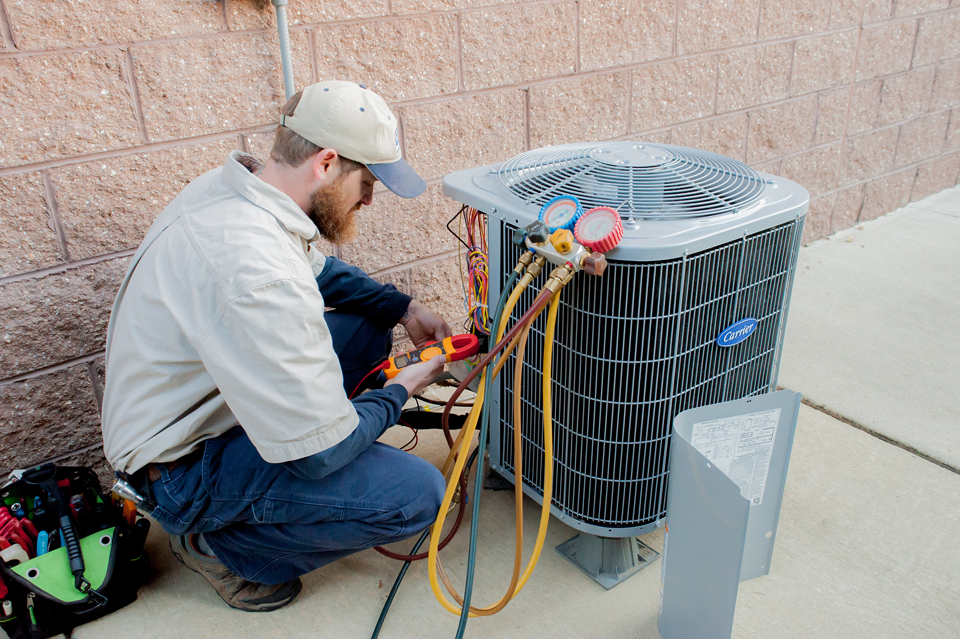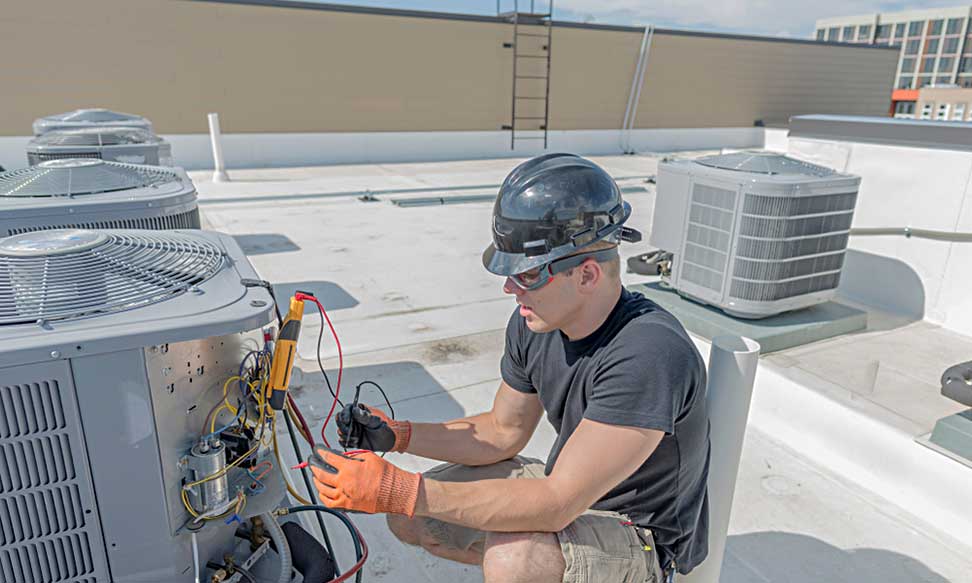Exactly How a Warmth Pump and Heating System Interact to Maximize Your Home's Heating Efficiency
Recognizing just how a warmth pump and furnace interact is essential for homeowners seeking reliable heating solutions. Each system has its toughness, supplying a well balanced approach to home comfort. The warmth pump excels in modest temperatures, while the heater delivers quick warmth throughout extreme cold. This harmony not just minimizes energy expenses but additionally enhances the life-span of both home appliances. What elements affect this partnership, and just how can property owners maximize their advantages?
Understanding Warm Pumps: Just How They Work
Although numerous individuals may be not familiar with their inner operations, heatpump play an important function in modern-day furnace. These tools run by transferring warm from one place to another, using the concepts of thermodynamics. In colder months, a heatpump removes warmth from the outside air, ground, or water, and transfers it indoors to warm up the living room. Conversely, during warmer months, it can reverse the procedure, working as an air conditioning system by expelling warm from inside to the outside.Heat pumps contain an evaporator, development, condenser, and compressor valve. The cooling agent within the system takes in warm as it evaporates at reduced temperature levels and stress. The compressor after that increases the stress and temperature of the refrigerant, enabling it to release heat as it condenses. This efficient process can significantly minimize energy consumption compared to traditional home heating approaches, making warmth pumps a lasting choice for climate control in homes.
The Function of Furnaces in Home Heating
Heaters play a crucial duty in home heating by giving a trusted resource of heat during the colder months. They run by creating warm through burning or electrical resistance, dispersing it throughout the home via ducts or glowing systems. The effectiveness of a heater is usually gauged by its Yearly Gas Use Effectiveness (AFUE) rating, which indicates just how successfully the system transforms gas into heat.Furnaces can utilize numerous power resources, including gas, gas, electrical energy, or oil, enabling homeowners to select one of the most suitable option for their demands. Unlike warm pumps, which might battle in extreme cool, heating systems preserve consistent efficiency, ensuring that interior temperatures continue to be comfortable no matter exterior problems. In addition, modern heating systems commonly come geared up with sophisticated modern technology, such as variable-speed blowers and smart thermostats, enhancing their performance and responsiveness. This flexibility makes heating systems a vital element in all-inclusive home heating techniques.

Advantages of Using Both Systems Together
Combining the strengths of both heaters and heatpump can lead to an extra effective and efficient home heating solution. Making use of both systems enables house owners to make the most of the heatpump's energy performance throughout milder temperature levels while counting on the furnace for even more extreme cold conditions. This twin method can greatly lower power expenses, as heatpump take in much less electricity than typical heating techniques when temperature levels are moderate.Additionally, making use of both systems together can boost comfort degrees in the home. Heatpump can provide regular, even home heating, while heating systems can promptly increase ambient temperature levels when needed. The integration of both systems can prolong the life-span of devices by decreasing wear and tear on each device, as they share the work. Ultimately, house owners can enjoy a balanced, economical heating option that readjusts perfectly to differing climate condition, making certain a warm and inviting home throughout the winter season.
How Warm Pumps and Furnaces Enhance Each Other
They develop a complementary home heating system that makes best use of effectiveness and convenience when property owners incorporate warmth pumps and furnaces. Heatpump operate by transferring warmth from the outdoors air or ground, making them very reliable in moderate climates. They excel during milder temperature levels, providing affordable heating. On the other hand, heaters create warmth via burning or electrical resistance, delivering solid, prompt heat during severe cold conditions.The mix of these two systems permits dynamic adjustments based upon temperature level variations. Throughout warmer months or milder wintertime days, the warm pump can take the lead, saving power and minimizing expenses. As temperatures drop, the furnace can seamlessly involve, making certain regular warmth throughout the home. This harmony not just optimizes power usage yet likewise enhances the life-span of both systems, as each device runs within its suitable performance range. With each other, they develop a balanced setting that adapts to varying climate needs.
Enhancing Efficiency: Tips for Homeowners
Home owners can enhance their heating performance with several practical techniques. Establishing a regular upkeep timetable, integrating clever thermostat innovation, and applying efficient insulation and sealing remedies are crucial actions. These actions not only improve convenience but additionally minimize energy prices.
Routine Maintenance Arrange
To ensure maximum home heating efficiency, developing a regular upkeep routine is essential for any type of home. Homeowners ought to prioritize regular evaluations of both warmth pumps and heaters to establish peak efficiency. This includes changing air filters each to three months, as clogged up filters can significantly minimize efficiency. In addition, scheduling professional maintenance at the very least once a year allows service technicians to identify and resolve potential problems before they intensify. Home owners must also clean the heatpump's outside unit to stop debris look at here build-up that can impede air flow. By adhering to a routine upkeep timetable, home owners not only improve their heater' performance yet likewise expand their life-span, leading to greater comfort and minimized power prices throughout the colder months.
Smart Thermostat Integration
Integrating a smart thermostat into a home furnace can substantially boost energy efficiency, specifically as it enables accurate control over temperature settings. These devices can learn the home owner's routine and preferences, automatically readjusting the temperature to enhance comfort while reducing power usage. For instance, they can decrease heating during times when the home is unoccupied, lowering unneeded intake. Lots of wise thermostats additionally give real-time energy use data, allowing homeowners to make informed decisions regarding their heating practices. Furthermore, remote gain access to by means of mobile phone applications allows users to change setups from anywhere, making sure the home is warm upon return. In general, clever thermostat combination not just improves comfort yet significantly adds to power savings and performance.
Insulation and Securing Solutions
Smart thermostats play a crucial role in power performance, however their efficiency can be substantially improved by proper insulation and securing options. Homeowners ought to prioritize shielding walls, floorings, and attic rooms to reduce warm loss. Top notch insulation products, such as spray foam or fiberglass, can greatly enhance thermal resistance. Furthermore, securing spaces around ducts, doors, and home windows avoids cool air infiltration and warmth getaway. Weatherstripping and caulking work methods for addressing these leakages - heat pump replacement ooltewah tn. Routine evaluations for air leakages, along with making use of blower door tests, can assist determine issue areas. By buying insulation and securing, property owners can optimize the performance of their heater, eventually resulting in decreased power intake and lower energy costs
Common Myths Regarding Warm Pumps and Furnaces
What false impressions border warmth pumps and heating systems? Several people wrongly think that heatpump are inefficient in colder climates. In truth, contemporary warm pumps are designed to run effectively also in reduced temperatures, offering trusted home heating throughout winter. Another typical myth is that furnaces are always a lot more reliable than warmth pumps. This depends on the particular energy sources and effectiveness scores of the devices in inquiry. Some may additionally think that using both systems all at once is unnecessary, however in fact, this combination can enhance heating efficiency, specifically throughout severe climate problems. Furthermore, individuals often think that heatpump call for consistent upkeep, when actually, they have comparable additional resources maintenance needs to traditional heater. By unmasking these misconceptions, homeowners can make even more enlightened choices regarding their home heating choices, ultimately resulting in improved convenience and power performance in their homes.
Maintenance Factors To Consider for Combined Systems

Frequently Asked Concerns
Can Warmth Pumps Job Successfully in Exceptionally Cold Climates?
Heatpump can struggle in incredibly cool climates as a result of decreased effectiveness and warm extraction limitations. Improvements in technology have led to versions designed for far better efficiency in such problems, improving their feasibility in rough environments.
The Length Of Time Do Warmth Pumps and Furnaces Normally Last?
Heatpump typically last 15 to twenty years, while furnaces have a life expectancy of 15 to 30 years. Normal upkeep can prolong their durability, guaranteeing efficient procedure and minimizing the need for premature replacements.

What Is the Typical Price of Putting Up Both Solutions?
The typical expense of setting up both a heatpump and a heater usually varies in between $5,000 to $10,000 - heat pump service. Variables affecting this expense consist of system size, installment complexity, and local labor rates
Exist Tax Incentives for Making Use Of Energy-Efficient Home Heating Systems?
Lots of homeowners ask about tax obligation motivations for energy-efficient heating unit. Numerous government and state programs frequently use rebates or debts, motivating the adoption of sustainable technologies to lower power consumption and promote environmental obligation.
Exactly how Do I Select the Right Dimension Warm Pump and Heating System?
Selecting the ideal size heatpump and heater includes computing the home's square footage, thinking about insulation top quality, and examining neighborhood environment. Consulting a specialist can assure suitable system efficiency and power efficiency based upon details demands. heat pump installation ooltewah tn. Understanding just how a warmth pump and heater job together is important for homeowners seeking reliable home heating services. In chillier months, a heat pump extracts warmth from the outdoors air, ground, or water, and transfers it inside your home to heat the living room. When property owners incorporate warm pumps and heating systems, they develop a corresponding heating system that takes full advantage of performance and comfort. Warmth pumps operate by moving warmth from the outside air or ground, making them very reliable in moderate environments. Warmth pumps can battle in exceptionally cold environments due to reduced efficiency and warm extraction constraints
 Jennifer Grey Then & Now!
Jennifer Grey Then & Now! Alicia Silverstone Then & Now!
Alicia Silverstone Then & Now! Barbi Benton Then & Now!
Barbi Benton Then & Now! Raquel Welch Then & Now!
Raquel Welch Then & Now! Lisa Whelchel Then & Now!
Lisa Whelchel Then & Now!